Created by Will Eisner Team affiliations Central City's Police | Alter ego Denny Colt Adaptations The Spirit (2008) Publishers Eisner & Iger, DC Comics | |
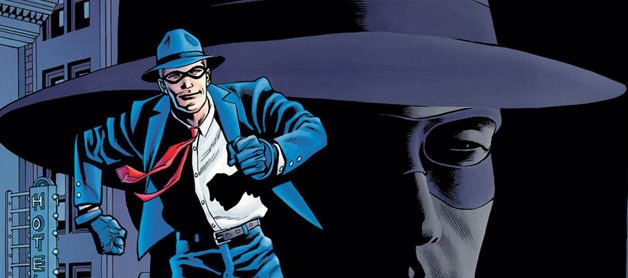 | ||
First appearance Register and Tribune Syndicate, June 2, 1940 Abilities Superhuman longevity
Healing factor (Movie Adaptation)
Outstanding athlete
Outstanding hand-to-hand combatant
Master detective Similar Dick Tracy, Terry and the Pirates, Prince Valiant, The Phantom, Krazy Kat | ||
The Spirit is a fictional masked crimefighter created by cartoonist Will Eisner. He first appeared June 2, 1940, as the main feature of a 16-page, tabloid-sized, newsprint comic book insert distributed in the Sunday edition of Register and Tribune Syndicate newspapers; it was ultimately carried by 20 Sunday newspapers, with a combined circulation of five million copies during the 1940s. "The Spirit Section", as the insert was popularly known, continued until October 5, 1952. It generally included two other, four-page strips (initially Mr. Mystic and Lady Luck), plus filler material. Eisner was the editor, but also wrote and drew most entries—after the first few months, he had the uncredited assistance of writer Jules Feiffer and artists Jack Cole and Wally Wood, though Eisner's singular vision for the character was a unifying factor.
Contents
- Publication history
- Fictional character biography
- Ebony White
- Other characters
- The Spirit and John Law
- Assistants and collaborators
- 1960s
- 1970s
- 1980s
- 1990s and beyond
- DC Comics
- IDW
- Dynamite Entertainment
- Comic strip
- TV movie
- Planned animated movie
- Film
- Radio
- Collected editions
- References

The Spirit chronicles the adventures of a masked vigilante who fights crime with the blessing of the city's police commissioner Dolan, an old friend. Despite the Spirit's origin as detective Denny Colt, his real identity was virtually unmentioned again, and for all intents and purposes he was simply "the Spirit". The stories are presented in a wide variety of styles, from straightforward crime drama and noir to lighthearted adventure, from mystery and horror to comedy and love stories, often with hybrid elements that twisted genre and reader expectations.
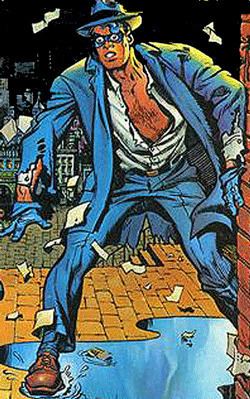
From the 1960s to 1980s, a handful of new Eisner Spirit stories appeared in Harvey Comics and elsewhere, and Warren Publishing and Kitchen Sink Press variously reprinted the newspaper feature in black-and-white comics magazines and in color comic books. In the 1990s and 2000s, Kitchen Sink Press and DC Comics also published new Spirit stories by other writers and artists.
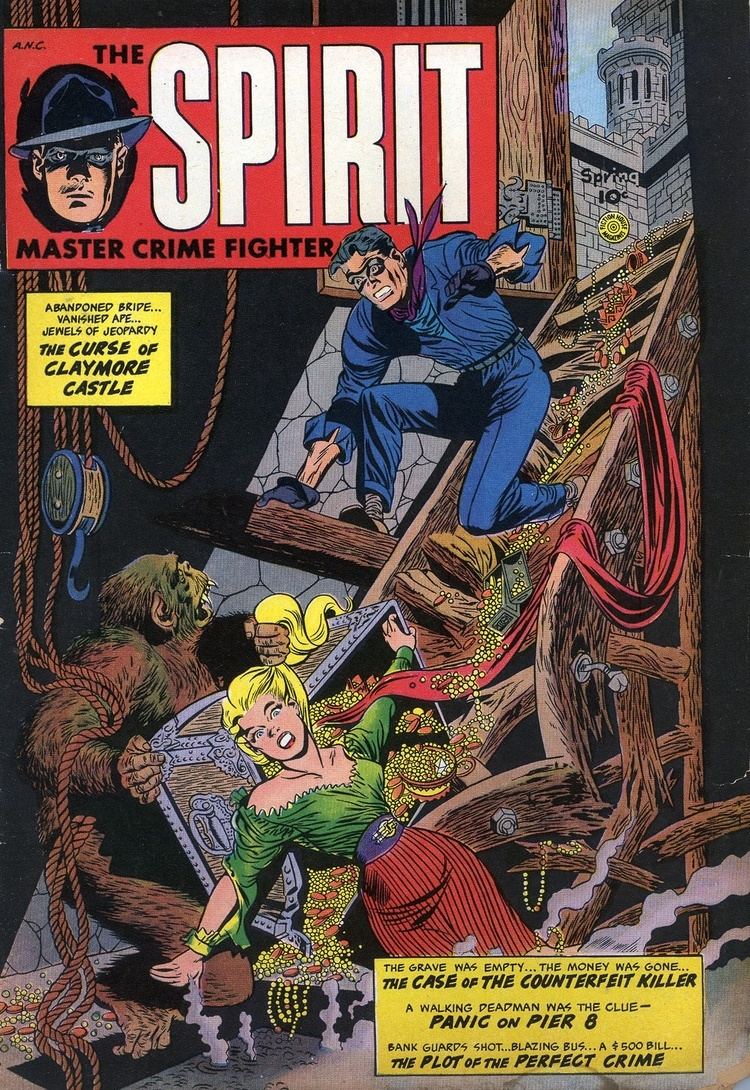
In 2011, IGN ranked him 21st in the Top 100 Comic Book Heroes.
Publication history

In late 1939, Everett M. "Busy" Arnold, publisher of the Quality Comics comic-book line, began exploring an expansion into newspaper Sunday supplements, aware that many newspapers felt they had to compete with the suddenly burgeoning new medium of American comic books, as exemplified by the Chicago Tribune Comic Book, premiering two months before The Spirit Section. Arnold compiled a presentation piece with existing Quality Comics material. An editor of The Washington Star liked George Brenner's comic-book feature "The Clock", but not Brenner's art, and was favorably disposed toward a Lou Fine strip. Arnold, concerned over the meticulous Fine's slowness and his ability to meet deadlines, claimed it was the work of Eisner, Fine's boss at the Eisner & Iger studio, from which Arnold bought his outsourced comics work.
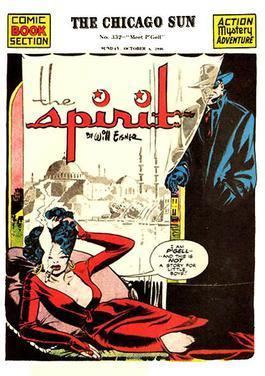
In "late '39, just before Christmas time," Eisner recalled in 1979, "Arnold came to me and said that the Sunday newspapers were looking for a way of getting into this comic book boom". In a 2004 interview, Eisner elaborated on that meeting:

"Busy" invited me up for lunch one day and introduced me to [sales manager of the Des Moines Register and Tribune Syndicate] Henry Martin, who said, "The newspapers in this country, particularly the Sunday papers, are looking to compete with comics books, and they would like to get a comic-book insert into the newspapers"... Martin asked if I could do it... It meant that I'd have to leave Eisner & Iger [which] was making money; we were very profitable at that time and things were going very well. A hard decision. Anyway, I agreed to do the Sunday comic book and we started discussing the deal [which] was that we'd be partners in the "Comic Book Section", as they called it at that time.

Eisner negotiated an agreement with the syndicate in which Arnold would copyright The Spirit, but, "Written down in the contract I had with 'Busy' Arnold — and this contract exists today as the basis for my copyright ownership — Arnold agreed that it was my property. They agreed that if we had a split-up in any way, the property would revert to me on that day that happened. My attorney went to 'Busy' Arnold and his family, and they all signed a release agreeing that they would not pursue the question of ownership." This would include the eventual backup features, "Mr. Mystic" and "Lady Luck."
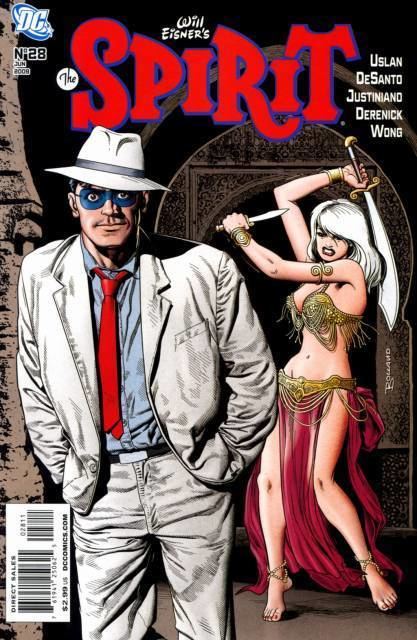
Selling his share of their firm to Iger, who would continue to package comics as the S. M. Iger Studio and as Phoenix Features through 1955, for $20,000, Eisner left to create The Spirit. "They gave me an adult audience", Eisner said in 1997, "and I wanted to write better things than superheroes. Comic books were a ghetto. I sold my part of the enterprise to my associate and then began The Spirit. They wanted an heroic character, a costumed character. They asked me if he'd have a costume. And I put a mask on him and said, 'Yes, he has a costume!'"
The character and the types of stories Eisner would tell, Eisner said in 1978, derived from his desire
...to do short stories. I always regarded comics as a legitimate medium, my medium. Creating a detective character would... provide me with the most viable vehicle for the kind of stories I could best tell. The syndicate people weren't in full agreement with me... [I]n my first discussion with 'Busy' Arnold, his thinking centered around a superhero kind of character—a costumed character; we didn't use the word 'superhero' in those days... and I argued vehemently against it because I [had] had my bellyful of creating costumed heroes at Eisner and Iger... [S]o actually one evening, around three in the morning, I was still working, trying to find it—I only had about a week-and-a-half or two weeks in which to produce the first issue, the whole deal was done in quite a rush—and I came up with an outlaw hero, suitable, I felt, for an adult audience.
The character's name, he said in that interview, came from Arnold: "When 'Busy' Arnold called, he suggested a kind of ghost or some kind of metaphysical character. He said, 'How about a thing called the Ghost?' and I said, 'Naw, that's not any good,' and he said, 'Well, then, call it the Spirit; there's nothing like that around.' I said, 'Well, I don't know what you mean.,' and he said, 'Well, you can figure that out—I just like the words "the Spirit."' He was calling from a bar somewhere, I think... [A]nd actually, the more I thought about it the more I realized I didn't care about the name."
The Spirit, an initially eight- and later seven-page urban-crimefighter series, ran with the initial backup features "Mr. Mystic" and "Lady Luck" in a 16-page Sunday supplement (colloquially called "The Spirit Section") that was eventually distributed in 20 newspapers with a combined circulation of as many as five million copies. It premiered June 2, 1940, and continued through 1952.
Eisner was drafted into the U.S. Army in late 1941, "and then had about another half-year which the government gave me to clean up my affairs before going off" to fight in World War II. In his absence, the newspaper syndicate used ghost writers and artists to continue the strip, including Manly Wade Wellman, William Woolfolk, and Lou Fine.
Eisner's rumpled, masked hero (with his headquarters under the tombstone of his supposedly deceased true identity, Denny Colt) and his gritty, detailed view of big-city life (based on Eisner's Jewish upbringing in New York City) both reflected and influenced the noir outlook of movies and fiction in the 1940s. Eisner said in 2001 that he created the strip as a vehicle to explore various genres: "When I created The Spirit, I never had any intention of creating a superhero. I never felt The Spirit would dominate the feature. He served as a sort of an identity for the strip. The stories were what I was interested in." In some episodes, the nominal hero makes a brief, almost incidental appearance while the story focuses on a real-life drama played out in streets, dilapidated tenements, and smoke-filled back rooms. Yet along with violence and pathos, The Spirit lived on humor, both subtle and overt. He was machine-gunned, knocked silly, bruised, often amazed into near immobility and constantly confused by beautiful women.
The feature ended with the October 5, 1952, edition. As The Comics Journal editor-publisher Gary Groth wrote, "By the late '40s, Eisner's participation in the strip had dwindled to a largely supervisory role. ... Eisner hired Jerry Grandenetti and Jim Dixon to occasionally ink his pencils. By 1950, [Jules] Feiffer was writing most of the strips, and Grandenetti, Dixon, and Al Wenzel were drawing them." — Grandenetti penciling as a ghost-artist, under Eisner's byline, said in 2005 that before the feature's demise, Eisner had "tried everything. Had me penciling 'The Spirit'. Later on it was Wally Wood", who drew the final installments.
Fictional character biography
The Spirit, referred to in one newspaper article cited below as "the only real middle-class crimefighter", was the hero persona of young detective Denny Colt. (To be precise, Dennis Colt Jr.) Presumed killed in the first three pages of the premiere story, Colt later revealed to his friend, Central City Police Commissioner Dolan, that he had in fact gone into suspended animation caused by one of archvillain Dr. Cobra's experiments. When Colt awakened in Wildwood Cemetery, he established a base there and, using his new-found anonymity, began a life of fighting crime wearing only a small domino mask, blue business suit, red necktie, fedora hat, and gloves for a costume. The Spirit dispensed justice with the aid of his assistant, Ebony White, funding his adventures with the rewards for capturing villains.
The Spirit originally was based in New York City, but this was quickly changed to the fictional "Central City". Not tied to one locale, his adventures took him around the globe. He met eccentrics, kooks, and femme fatales, bringing his own form of justice to all of them. The story changed continually, but certain themes remained constant: the love between the Spirit and Dolan's feisty protofeminist daughter Ellen; the annual "Christmas Spirit" stories; and the Octopus (a psychopathic criminal mastermind who was never seen, except for his distinctive gloves).
Ebony White
Eisner was criticized for his depiction of Ebony White, the Spirit's African-American sidekick. The character's name is a racial pun, and his facial features, including large white eyes and thick pinkish lips, are typical of racial blackface caricatures popular throughout the "Jim Crow" era. Eisner later admitted to consciously stereotyping the character, but said he tried to do so with "responsibility", and argued that "at the time humor consisted in our society of bad English and physical difference in identity". The character, who was consistently treated with respect by the strip's fellow cast-members, developed beyond the stereotype as the series progressed, and Eisner also introduced such African-American characters as the no-nonsense Detective Grey who defied popular stereotypes.
In a 1966 New York Herald Tribune feature, Eisner's former office manager Marilyn Mercer wrote, "Ebony never drew criticism from Negro groups (in fact, Eisner was commended by some for using him), perhaps because, although his speech pattern was early Minstrel Show, he himself derived from another literary tradition: he was a combination of Tom Sawyer and Penrod, with a touch of Horatio Alger hero, and color didn't really come into it".
Other characters
The Spirit and John Law
Several Spirit stories, such as the first appearance of Sand Saref, were retooled from a failed publishing venture featuring an eyepatched, pipe-smoking detective named John Law. Law and his shoeshine-boy sidekick, Nubbin, starred in several adventures planned for a new comics series. These completed adventures were eventually adapted into Spirit stories, with John Law's eyepatch being changed to the Spirit's mask, and Nubbin redrawn as Willum Waif or other Spirit supporting characters.
The original John Law stories were restored and published in Will Eisner's John Law: Dead Man Walking (IDW Publishing, 2004), a collection of stories that also features new adventures by writer-artist Gary Chaloner, starring John Law, Nubbin, and other Eisner creations, including Lady Luck and Mr. Mystic.
Assistants and collaborators
Like most artists working in newspaper comic strips, Eisner after a time employed a studio of assistants who, on any given week's story, might draw or simply ink backgrounds, ink parts of Eisner's main characters (such as clothing or shoes), or as eventually occurred, ghost-draw the strip entirely. Eisner also eventually used ghostwriters, generally in collaboration with him.
Jules Feiffer, who began as an art assistant circa 1946 and later became the primary writer through the strip's end in 1952, recalled, "When I first worked for Will there was John Spranger, who was his penciler and a wonderful draftsman; better than Will. There was Sam Rosen, the lettering man. Jerry Grandenetti came a little after me and did backgrounds, and Jerry had some architectural background. His drawing was stiff but loosened up after a while, but he drew backgrounds and inked them beautifully. And Abe Kanegson, who was my best friend in the office, was a jack-of-all-trades but mostly did lettering and backgrounds after Jerry left. Abe was a mentor to me."
Eisner's studio also included:
1960s
A five-page Spirit story, set in New York City, appeared as part of a January 9, 1966, article about the Spirit in the New York Herald Tribune.
Harvey Comics reprinted several Spirit stories in two giant-size, 25-cent comic books published October 1966 and March 1967, each with new Eisner covers. The first of these two 60-page issues opened with a new seven-page retelling of the Spirit's origin by writer-penciler-inker Eisner (with inking assist by Chuck Kramer). Also new was the text feature "An Interview With the Spirit", credited to Marilyn Mercer; and writer-artist Eisner's two-page featurette "Spirit Lab: Invincible Devices". Seven 1948–1949 Spirit stories were reprinted.The second issue opened with a new seven-page story by writer-artist Eisner, "Octopus: The Life Story of the King of Crime," giving the heretofore unrevealed origin of the Spirit's nemesis The Octopus, as well as his given name (Zitzbath Zark). Also new was the two-page text feature "The Spirit Answers Your Mail", and writer-artist Eisner's two-page featurette "The Spirit Lab: The Man From MSD". Reprinted were seven 1948–50 Spirit stories.
1970s
From 1973 onward Denis Kitchen's Kitchen Sink Press and James Warren's Warren Publishing published extensive Spirit reprints, first as large black-and-white magazines (the Warren part of the run eventually having a color section), then as trade paperbacks. The magazines often featured new Eisner covers. The first ongoing series, started by Warren and picked up by Kitchen Sink, ran 41 issues from 1974–1983.
Two new stories were written during this period: "The Capistrano Jewels", a four-page story published in the second issue of the Kitchen Sink reprints in 1973; and "The Invader", a five-page story (reprinted in The Will Eisner Color Treasury, Kitchen Sink Press, 1981). Issue #30 of the Kitchen Sink series (July 1981) features "The Spirit Jam", with a script from Eisner and a few penciled pages, plus contributions from 50 artists, including Fred Hembeck, Trina Robbins, Steve Leialoha, Frank Miller, Harvey Kurtzman, Howard Cruse, Brian Bolland, Bill Sienkiewicz, John Byrne, and Richard Corben.
In 1976, Tempo Books published The Spirit Casebook of True Haunted Houses and Ghosts. The Spirit plays the EC host, introducing "true" stories of haunted houses. The Spirit also makes a cameo in Vampirella #50 (April 1976), in the eight-page story "The Thing in Denny Colt's Grave".
1980s
Kitchen Sink Press did a complete reprinting of the post-WWII Eisner work in a color comics series, which ran 87 issues (Oct. 1983 - Jan. 1992). The publisher additionally published the one-shot Will Eisner's 3-D Classics featuring The Spirit (Dec. 1985); The Spirit Casebook, two issues of which appeared, in 1990 and 1998, the former cover-titled simply Spirit Casebook, the latter cover-titled All About P'Gell; and the eight-issue The Spirit: The New Adventures (March-Nov. 1998).
1990s and beyond
Kitchen Sink also published a series of original Spirit stories in 1996–1997, including contributions from Alan Moore, Dave Gibbons, Paul Chadwick, Neil Gaiman, Joe R. Lansdale and Paul Pope.
In the mid-2000s, DC Comics began reprinting The Spirit chronologically in the company's hardcover Archive series, in an approximately 8x10-inch format, smaller than the Kitchen Sink and Warren publications.
The final Spirit art by the late Eisner appeared in the sixth issue of The Amazing Adventures of the Escapist, from Dark Horse Comics.
DC Comics
The DC Comics one-shot Batman/The Spirit (January 2007), by writer Jeph Loeb and artists Darwyn Cooke and J. Bone introduced the Spirit into the DC Universe. The first issue of the ongoing series The Spirit, written and pencilled by Cooke and inked by J. Bone, debuted the following month. The series updated some concepts, with Ellen's Internet skills helping to solve a case, and Ebony White stripped of his racial stereotype characteristics. The team of Mark Evanier and Sergio Aragones became the series' regular writers beginning with issue #14 (March 2008), with Mike Ploog and later Paul Smith providing the artwork. DC'S The Spirit series ran through issue #32 (Aug. 2009), with most running a single 22-page story.
IDW
In 2013, IDW published a four issue miniseries, The Rocketeer and The Spirit: Pulp Friction, using The Spirit, Dolan, Ellen, and the Octopus as well as characters from Dave Stevens's The Rocketeer series. The four issues were collected in a hardcover graphic novel.
Dynamite Entertainment
In 2015, Dynamite Entertainment obtained the rights to publish new Spirit comics, beginning with a story by writer-artist Matt Wagner, "Who Killed The Spirit?"
Comic strip
From October 1941 to March 1944, there was also a daily, black-and-white newspaper strip of The Spirit. These were later reprinted in several collections. DC's The Spirit Archives Volume 25 collected all these strips.
Reprints of the Spirit's adventures ran in Quality Comics and Fiction House publications shortly after their newspaper debuts.
TV-movie
The character was the subject of a 1987 television movie starring Sam J. Jones as the Spirit, Nana Visitor as Ellen Dolan, and Garry Walberg as Commissioner Dolan. The film served as a pilot for a planned TV series.
Planned animated movie
An animated feature to be directed by Brad Bird was in development in the 1980s.
Film
The film adaptation The Spirit, written and directed by Frank Miller, was released in theaters by Lionsgate on December 25, 2008. The film stars Gabriel Macht as the Spirit and Samuel L. Jackson as the Octopus.
Radio
Denis Kitchen, the Eisner estate's agent, said in a July 8, 2006 online interview that a radio series had been in development: "It was pitched to the estate by a couple of producers, one of whom is very experienced with NPR, so we have been back and forth on how that would work. Again, it would be premature to tell you it is going to happen, but it is in serious discussion."
Collected editions
The comic strips and comics have been collected into a number of volumes:
